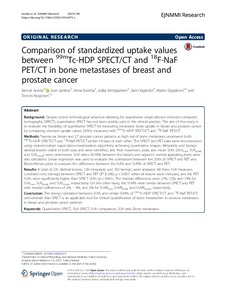Comparison of standardized uptake values between Tc-99m-HDP SPECT/CT and F-18-NaF PET/CT in bone metastases of breast and prostate cancer
Arvola Samuli; Jambor Ivan; Kuisma Anna; Kemppainen Jukka; Kajander Sami; Seppänen Marko; Noponen Tommi
Comparison of standardized uptake values between Tc-99m-HDP SPECT/CT and F-18-NaF PET/CT in bone metastases of breast and prostate cancer
Arvola Samuli
Jambor Ivan
Kuisma Anna
Kemppainen Jukka
Kajander Sami
Seppänen Marko
Noponen Tommi
SPRINGEROPEN
Julkaisun pysyvä osoite on:
https://urn.fi/URN:NBN:fi-fe2021042822632
https://urn.fi/URN:NBN:fi-fe2021042822632
Tiivistelmä
Background: Despite recent technological advances allowing for quantitative single-photon emission computed tomography (SPECT), quantitative SPECT has not been widely used in the clinical practice. The aim of this study is to evaluate the feasibility of quantitative SPECT for measuring metastatic bone uptake in breast and prostate cancer by comparing standard uptake values (SUVs) measured with Tc-99m-HDP SPECT/CT and F-18-NaF PET/CT.
Methods: Twenty-six breast and 27 prostate cancer patients at high risk of bone metastases underwent both Tc-99m-HDP SPECT/CT and F-18-NaF PET/CT within 14days of each other. The SPECT and PET data were reconstructed using ordered-subset expectation-maximization algorithms achieving quantitative images. Metastatic and benign skeletal lesions visible in both data sets were identified, and their maximum, peak, and mean SUVs (SUVmax, SUVpeak, and SUVmean) were determined. SUV ratios (SUVRs) between the lesions and adjacent normal appearing bone were also calculated. Linear regression was used to evaluate the correlations between the SUVs of SPECT and PET and Bland-Altman plots to evaluate the differences between the SUVs and SUVRs of SPECT and PET.
Results: A total of 231 skeletal lesions, 129 metastatic and 102 benign, were analyzed. All three SUV measures correlated very strongly between SPECT and PET (R(2)0.80, p<0.001) when all lesions were included, and the PET SUVs were significantly higher than SPECT SUVs (p<0.001). The median differences were 21%, 12%, and 19% for SUVmax, SUVpeak, and SUVmean, respectively. On the other hand, the SUVRs were similar between SPECT and PET with median differences of 2%, -9%, and 2% for SUVRmax, SUVRpeak, and SUVRmean, respectively.
Conclusion: The strong correlation between SUVs and similar SUVRs of Tc-99m-HDP SPECT/CT and F-18-NaF PET/CT demonstrate that SPECT is an applicable tool for clinical quantification of bone metabolism in osseous metastases in breast and prostate cancer patients.
Kokoelmat
- Rinnakkaistallenteet [27094]
